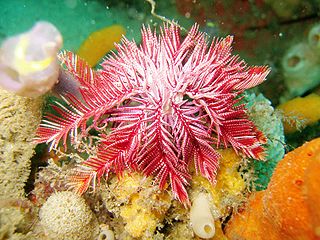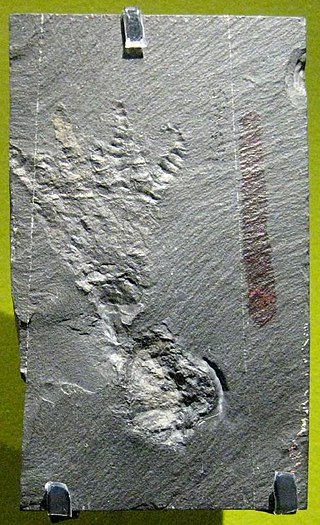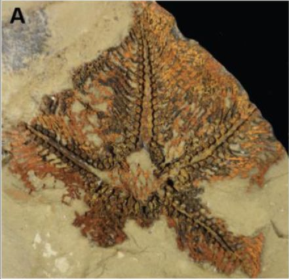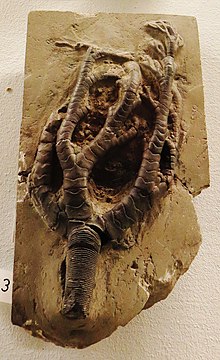
Trilobites are extinct marine arthropods that form the class Trilobita. Trilobites form one of the earliest known groups of arthropods. The first appearance of trilobites in the fossil record defines the base of the Atdabanian stage of the Early Cambrian period and they flourished throughout the lower Paleozoic before slipping into a long decline, when, during the Devonian, all trilobite orders except the Proetida died out. The last extant trilobites finally disappeared in the mass extinction at the end of the Permian about 252 million years ago. Trilobites were among the most successful of all early animals, existing in oceans for almost 270 million years, with over 22,000 species having been described.

Crinoids are marine animals that make up the class Crinoidea. Crinoids that are attached to the sea bottom by a stalk in their adult form are commonly called sea lilies, while the unstalked forms are called feather stars or comatulids, which are members of the largest crinoid order, Comatulida. Crinoids are echinoderms in the phylum Echinodermata, which also includes the starfish, brittle stars, sea urchins and sea cucumbers. They live in both shallow water and in depths as great as 9,000 meters (30,000 ft).

Nektaspida is an extinct order of non-mineralised artiopodan arthropods. They are known from the mid-Cambrian to the upper Silurian. Originally classified as trilobites, which they superficially resemble, they are now placed as close relatives as members of the Trilobitomorpha within Artiopoda. The order is divided into three major families; Emucarididae, Liwiidae, and Naraoiidae.

Articulata are a subclass or superorder within the class Crinoidea, including the only living crinoid species. They are commonly known as sea lilies or feather stars. The Articulata are differentiated from the extinct subclasses by their lack of an anal plate in the adult stage and the presence of an entoneural system. Articulata first appeared in the fossil record during the Triassic period although other, now extinct crinoid groups, originated in the Ordovician.

The Eocrinoidea are an extinct class of echinoderms that lived between the Early Cambrian and Late Silurian periods. They are the earliest known group of stalked, arm-bearing echinoderms, and were the most common echinoderms during the Cambrian.

Echmatocrinus is a Cambrian animal which resembles a crinoid or an octocoral. Its exact taxonomy is still a subject of debate. It is known only from the Burgess shale. 5 specimens of Echmatocrinus are known from the Greater Phyllopod bed, where they comprise < 0.1% of the community.
Paleontology or palaeontology is the study of prehistoric life forms on Earth through the examination of plant and animal fossils. This includes the study of body fossils, tracks (ichnites), burrows, cast-off parts, fossilised feces (coprolites), palynomorphs and chemical residues. Because humans have encountered fossils for millennia, paleontology has a long history both before and after becoming formalized as a science. This article records significant discoveries and events related to paleontology that occurred or were published in the year 2012.

Comatulida is an order of crinoids. Members of this order are known as feather stars and mostly do not have a stalk as adults. The oral surface with the mouth is facing upwards and is surrounded by five, often divided rays with feathery pinnules. Comatulids live on the seabed and on reefs in tropical and temperate waters.

Bourgueticrinida is an order of crinoids that typically live deep in the ocean. Members of this order are attached to the seabed by a slender stalk and are known as sea lilies. While other groups of crinoids flourished during the Permian, bourgueticrinids along with other extant orders did not appear until the Triassic, following a mass extinction event in which nearly all crinoids died out.

Cladida is a major subgroup of crinoids with a complicated taxonomic history. Lived about 370 million years ago. Cladida was originally applied to a wide assortment of extinct crinoids with a dicyclcic calyx. Under this original definition, cladids would represent a paraphyletic order ancestral to several other major crinoid groups, particularly the living Articulata. More recently, Cladida has been redefined as a monophyletic parvclass of pentacrinoids which encompasses articulates and the extinct Flexibilia (flexibles). Cladids also include various minor taxa such as the hybocrinids and "cyathocrines". As flexibles were not originally considered cladids, the new subgroup Eucladida has been erected for cladids which are more derived than flexibles. Cladida is the sister group to Disparida, another large group of extinct crinoids.

The Camerata or camerate crinoids are an extinct subclass of Paleozoic stalked crinoids. They were some of the earliest crinoids to originate during the Early Ordovician, reached their maximum diversity during the Mississippian, and became extinct during the Permian–Triassic extinction event. Camerates are the sister group of Pentacrinoidea, which contains all other crinoids. The two largest camerate subgroups are the orders Diplobathrida and Monobathrida.
Petalocrinidae is an extinct family of cladid crinoids from the Early Ordovician to Lower Devonian. Fossils of petalocrinoids have been found in China, Europe and the United States.
This list of fossil echinoderms described in 2014 is a list of new taxa of echinoderms of every kind that have been described during the year 2014. The list only includes taxa at the level of genus or species.
The Verulam Formation is a geologic formation and Lagerstätte in Ontario, Canada. It preserves fossils dating back to the Katian stage of the Ordovician period, or Shermanian to Chatfieldian in the regional stratigraphy.

Cincta is an extinct class of echinoderms that lived only in the Middle Cambrian epoch. Homostelea is a junior synonym. The classification of cinctans is controversial, but they are probably part of the echinoderm stem group.
Paleontology or palaeontology is the study of prehistoric life forms on Earth through the examination of plant and animal fossils. This includes the study of body fossils, tracks (ichnites), burrows, cast-off parts, fossilised feces (coprolites), palynomorphs and chemical residues. Because humans have encountered fossils for millennia, paleontology has a long history both before and after becoming formalized as a science. This article records significant discoveries and events related to paleontology that occurred or were published in the year 2018.
Disparida is an parvclass of extinct marine animals in the class Crinoidea. Disparids are a speciose and morphologically diverse group of crinoids distinguished by their monocyclic calyx and slender arms without pinnules. They range from the Early Ordovician (Tremadocian) to Middle Permian, reaching their highest diversity during the Late Ordovician.
Pentacrinoidea is a subclass of crinoids containing all members of Crinoidea except for the exclusively Paleozoic camerates. It was originally named in 1918 by Otto Jaekel, who hypothesized a fundamental split between camerate and non-camerate crinoids. Later workers doubted this interpretation, and Pentacrinoidea was rarely used during the rest of the 20th century. Recent phylogenetic work has provided strong support for Jaekel's hypothesis, and Pentacrinoidea was reinstated in a 2017 revision of crinoid systematics.

Villebrunaster is an extinct genus of starfish-like animal belonging to Asterozoa that lived around 480 million years ago during Early Ordovician Period in modern-day southern France and Morocco. As of 2022, it contains two species, namely V. thorali and V. fezouataensis. V. thorali was described in 1951 and V. fezouataensis was described in 2021. Villebrunaster represents one of the oldest members of asterozoans, and perhaps, according to a description in 2021, the earliest divergent stem-group of Asterozoa.















